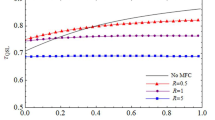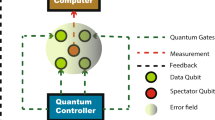Abstract
Measurement can reveal the difference between quantum physics and classical one. Recently, a quantum witness \(W_q\) was proposed to characterize quantumness (Li et al. in Sci Rep 2:885, 2012; Kofler and Brukner in Phys Rev A 87:052115, 2013). It is built upon the no-signaling-in-time condition, and there is only one-time intermediate measurement. As an extension, we consider here multiple intermediate measurements at different moments of time. And we discuss the quantumness of a damped and driven qubit. Uniform, quasiperiodic and random time-interval sequences (TISs) of measurements are considered, respectively. Numerical results show that \(W_q\) depends on the kind of TISs when the number of measurements N is less than 10, while it is almost independent of the kind of TISs when N is larger. Further, \(W_q\le W_q^{max}(N)=(1-\frac{1}{2N}) e^{-\gamma \tau }\) for all cases, where \(\tau \) is the evolution time, \(\gamma \) is the dephasing intensity, and \(W_q^{max}(N)\) is the maximum violation of the quantum witness equality.





Similar content being viewed by others
References
Heisenberg, W.: Über den anschaulichen Inhalt der quantentheoretischen Kinematik und Mechanik. Z. Phys. 43, 172 (1927)
Bohr, N.: Das Quantenpostulat und die neuere Entwicklung der Atomistik. Naturwissenschaften 16, 245 (1928)
Schrödinger, E.: Discussion of probability relations between separated systems. Proc. Cambridge Philos. Soc. 31, 555 (1935)
Landsman, N.P.: Between classical and quantum. In: Butterfield, J., Earman, J. (eds.) Handbook of the Philosophy of Physics. North-Holland, New York (2006)
Nielsen, M.A., Chuang, I.L.: Quantum Computation and Quantum Information. Cambridge University Press, Cambridge (2000)
Gisin, N., Thew, R.: Quantum communication. Nat. Photon. 1, 165 (2007)
Ladd, T.D., Jelezko, F., Laflamme, R., Nakamura, Y., Monroe, C., O’Brien, J.L.: Quantum computers. Nature 464, 45 (2010)
Giovannetti, V., Lloyd, S., Maccone, L.: Advances in quantum metrology. Nat. Photon. 5, 222 (2011)
Arkhipov, I.I., Peřina, J., Peřina, Jr.J., Miranowicz, A.: Comparative study of nonclassicality, entanglement, and dimensionality of multimode noisy twin beams. Phys. Rev. A 91, 033837 (2015)
Einstein, A., Podolsky, Yu., Rosen, N.: Can quantum-mechanical description of physical reality be considered complete? Phys. Rev. 47, 777 (1935)
Bohr, N.: Can quantum-mechanical description of physical reality be considered complete? Phys. Rev. 48, 696 (1935)
Mensky, M.B.: Quantum Measurement and Decoherence. Kluwer, Dordrecht (2000)
Busch, P., Lahti, P., Pellonpää, J.-P., Ylinen, K.: Quantum Measurement. Springer, Berlin (2016)
Li, C.M., Lambert, N., Chen, Y.N., Chen, G.Y., Nori, F.: Witnessing quantum coherence: from solid-state to biological systems. Sci. Rep. 2, 885 (2012)
Kofler, J., Brukner, Č.: Condition for macroscopic realism beyond the Leggett–Garg inequalities. Phys. Rev. A 87, 052115 (2013)
Schild, G., Emary, C.: Maximum violations of the quantum-witness equality. Phys. Rev. A 92, 032101 (2015)
Bell, J.S.: On the Einstein Podolsky Rosen paradox. Physics 1, 195 (1964)
Leggett, A.J., Garg, A.: Quantum mechanics versus macroscopic realism: Is the flux there when nobody looks? Phys. Rev. Lett. 54, 857 (1985)
Friedenberger, A., Lutz, E.: Assessing the quantumness of a damped two-level system. Phys. Rev. A 95, 022101 (2017)
Friedenberger, A., Lutz,E.: Tailoring the quantumness of a driven qubit. arXiv:1805.11882
Bojer, M., Friedenberger, A., Lutz, E.: Quantum witness of a damped qubit with generalized measurements. J. Phys. Commun. 3, 065003 (2019)
Alter, O., Yamamoto, T.: Quantum Measurement of a Single System. Wiley, New York (2001)
Müller, M.M., Gherardini, S., Smerzi, A., Caruso, F.: Fisher information from stochastic quantum measurements. Phys. Rev. A 94, 042322 (2016)
Wiseman, H.M., Milburn, G.J.: Quantum measurement and control. Cambridge University Press, Cambridge (2009)
Bernard, D., Jin, T., Shpielberg, O.: Transport in quantum chains under strong monitoring. Europhys. Lett. 121, 60006 (2018)
Barbieri, M.: Multiple-measurement Leggett–Garg inequalities. Phys. Rev. A 80, 034102 (2009)
Misra, B., Sudarshan, E.C.G.: The Zeno’s paradox in quantum theory. J. Math. Phys. 18, 756 (1977)
Cedzich, C., Werner, R.F.: Revivals in quantum walks with a quasiperiodically-time-dependent coin. Phys. Rev. A 93, 032329 (2016)
Maciá, E.: Aperiodic Structures in Condensed Matter: Fundamentals and Applications. CRC Press, Boca Raton (2009)
Nosrati, F., Mortezapour, A., Franco, R.L.: Validating and controlling quantum enhancement against noise by the motion of a qubit. Phys. Rev. A 101, 012331 (2020)
Acknowledgements
This work was supported by the National Natural Science Foundation of China (11504179, 11705097, 61271238 and 61475075).
Author information
Authors and Affiliations
Corresponding author
Additional information
Publisher's Note
Springer Nature remains neutral with regard to jurisdictional claims in published maps and institutional affiliations.
Appendices
Appendix A
For uniform TISs, based on Eq. (17) and at the driving amplitude \(\Delta =0.0\), quantum witness is reduced to
As the number of intermediate measurement times \(N\rightarrow \infty \) and \(\omega _0\tau \) is finite, \(\frac{\omega _0\tau }{N+1}\rightarrow 0\). Using Taylor expansion,
and
Therefore,
At \(\omega _0\tau =\pi \), \(W_q\approx [1-\frac{\pi ^2}{4(N+1)}]e^{-\gamma \tau }<W_q^{max}(N)\).
Appendix B
(Color online) a Probability \(p''_+\) and \(p_+\) as functions of time \(\tau \); Inset in a: Partial enlarger for \(\tau \) in the range [10, 12.5]. b Factor \(\chi \) as functions of time \(\tau \). For uniform, quasiperiodic and random TISs, the probability \(p''_+\) are denoted by \(p''^u_+, p''^f_+\) and \(p''^r_+\), and the factor \(\chi \) are denoted by \(\chi _u, \chi _f\) and \(\chi _r\), respectively. Intermediate measurement times \(N=10^4\). The driving amplitude \(\Delta =0.95\), the dephasing intensity \(\gamma =0.2\) and the original transition frequency \(\omega _0=1.0\)
For uniform, quasiperiodic and random TISs, Fig. 4d shows that quantum witness \(W_q\) as function of time \(\tau \) at intermediate measurement times \(N=10^4\). As given in Eq. (17),
where \(p_+(\tau )\) and \(p''_+(\tau )\) are the probabilities of the system in the \(|+\rangle \) eigenstate at last moment \(\tau \) in the presence and in the absence of multiple intermediate measurements. As given in Eq. (11),
so the probability \(p_+(\tau )\) exhibits underdamped behavior, which is shown in Fig. 6a. Based on Eqs. (15) and (16), we define a factor
then
Figure 6a shows that \(p''_+\) exhibits critically damped or overdamped behavior. The inset in Fig. 6a shows that there exist differences among \(p''^u_+, p''^f_+\) and \(p''^r_+\). On the whole, the differences are very small. In Eq.(B4), two factors, i.e., \(\exp (-\gamma \tau )\) and \(\chi \), make the decay of \(p''_+\). Fig. 6b shows that \(\chi \) smoothly decreases with time \(\tau \). In fact, at relative small \(\tau \), the differences among \(\chi _u, \chi _f\) and \(\chi _r\) are small. On the other hand, at relative large \(\tau \), there exist obvious differences among \(\chi _u, \chi _f\) and \(\chi _r\); at the same time, the factor \(\exp (-\gamma \tau )\) is smaller. Therefore, combined the two aspects, there are no obviously differences in \(p''^u_+, p''^f_+\) and \(p''^r_+\).
Appendix C
The system evolves within the range \([0, \tau ]\). The time interval is defined by \(\mu _n=\tau _n-\tau _{n+1}\), so the measurement moment \(\tau _n=\sum _{k=1}^{n}\mu _{k}\). The time interval \(\mu _n\) is generated from the two-point distribution, exponential distribution, normal distribution, respectively.
The two-point distribution is
We set \(\mu (C):\mu (D)=1:2\) and \(p_c=0.5\).
The exponential distribution function is
We set \(\lambda =1.0\).
The normal distribution function is
where \(\nu \) is the mean value and \(\sigma \) is the standard deviation. In calculation, we set \(\nu =0.0\) and \(\sigma =1\). At the same time, \(\mu >0\) is used.
(Color online) Quantum witness \(W_q\) as functions of time \(\tau \) with intermediate measurement times a \(N=1\), b \(N=2\), c \(N=10\) and d \(N=10^4\), respectively. For the two-point distribution, exponential distribution, normal distribution, intermediate measurement times N are denoted by \(N_t, N_e\) and \(N_n\), respectively. Here, \(W_q^{max}(N)=(1-\frac{1}{2N})e^{-\gamma \tau }\), the driving amplitude \(\Delta =0.95\), the dephasing intensity \(\gamma =0.2\) and the original transition frequency \(\omega _0=1.0\)
In calculations, the time interval \(\mu _n\) is generated from the above three different distributions. We also set \(\tau _0=0\) and \(\tau _{N+1}=\tau \). At last, \(\tau _n\) is rescaled by the restriction that \(\tau _{N+1}=\tau \). Quantum witness \(W_q\) as functions of time \(\tau \) is shown in Fig. 7a–d, respectively, where \(N=1,2,10\) and \(10^4\). It shows that for all cases, \(W_q(\tau )\le W_q^{max}(N)=(1-\frac{1}{2N}) e^{-\gamma \tau }\). When intermediate measurement times N are tens [Fig. 7a–c], \(W_q\) depends on the kind of TISs, while when N are larger [Fig. 7d], it is almost independent of the kind of TIS.
Rights and permissions
About this article
Cite this article
Gong, L., Ma, K., Zhao, X. et al. Quantum witness of a damped and driven qubit by sequential intermediate measurements with uniform and nonuniform time intervals. Quantum Inf Process 19, 260 (2020). https://doi.org/10.1007/s11128-020-02765-8
Received:
Accepted:
Published:
DOI: https://doi.org/10.1007/s11128-020-02765-8






